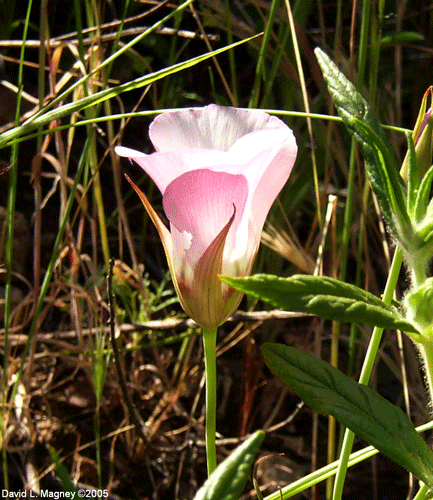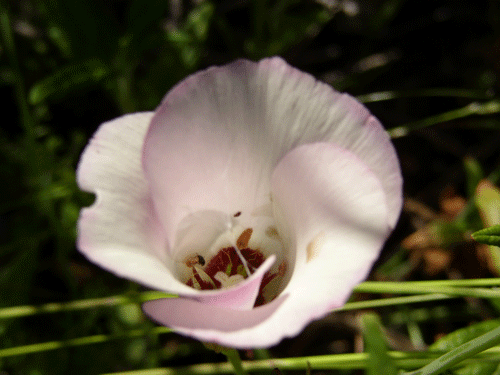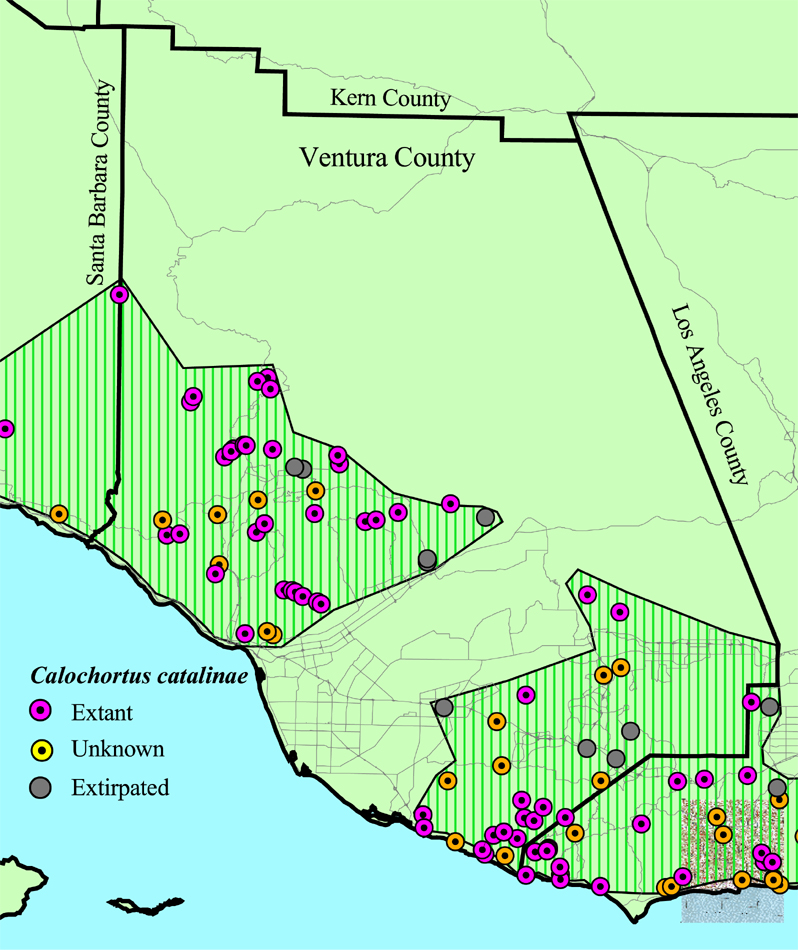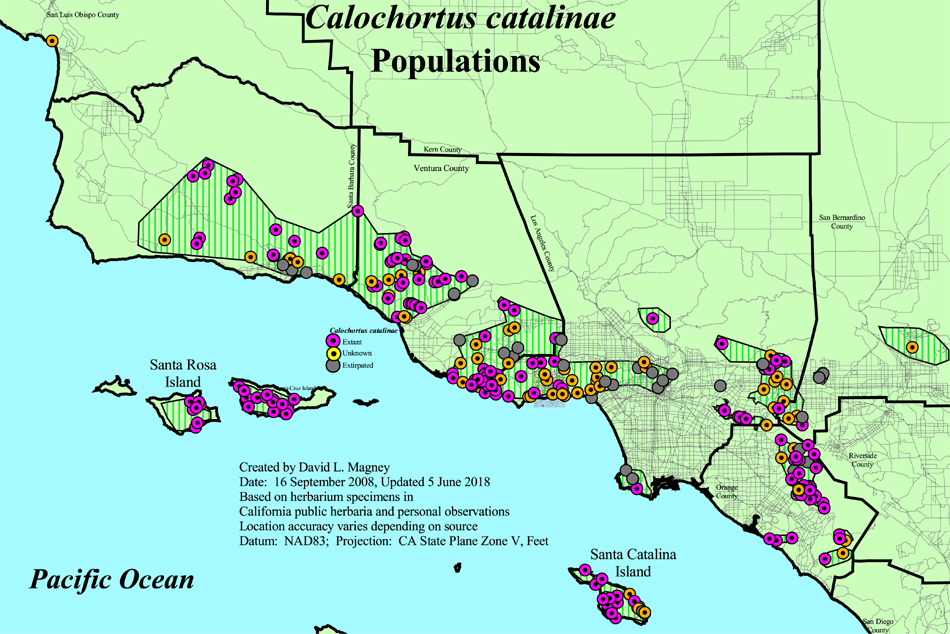CALIFORNIA NATIVE PLANT SOCIETY
Channel Islands Chapter
Channel Islands Chapter
Rare Plant Profiles:  Calochortus catalinae
Calochortus catalinae
 Calochortus catalinae
Calochortus catalinae
Calochortus catalinae S. Watson, Catalina Mariposa Lily, is a bulbiferous perennial herb in the Liliaceae (Lily family). It has bulblet-bearing stems 20 to 60 cm long, with withering basal leaves from 10 to 30 cm. The inflorescence consists of 1 to 4 erect, bowl-shaped flowers with purple-spotted (near base) sepals (20 to 30 mm) and white, tinged lilac, purple-spotted, nearly glabrous flowers. The flowers include oblong, densely branched, hairy nectaries (not depressed), and erect non-angled fruit (2 to 5 cm). Calochortus catalinae blooms between February and May.


Habitat and Distribution
Calochortus catalinae is an uncommon herb of heavy soil in open grassland, coastal scrub, and chaparral habitats and is primarily known below 700 meters/2,300 feet in elevation. It occurs primarily in the southern portion of the Central Coast and the western South Coast, and is known in San Luis Obispo, Santa Barbara, Ventura, Los Angeles, Orange, and San Bernardino Counties (including Santa Catalina, Santa Cruz, and Santa Rosa Islands). Undocumented, doubtful, or unsubstantiated occurrences elsewhere include Santa Diego County reports, and plants grown in botanic gardens.
Calochortus catalinae is sometimes observed on various slopes, primarily associated with Coastal Sage Scrub vegetation. It is locally common at many of its occurrences, particularly in Coastal Sage Scrub habitats. Calochortus catalinae contributes to the ground layer, growing below the intermittent shrub canopy along with the following common associates: Bloomeria crocea (Goldenstars), Calystegia macrostegia ssp. cyclostegia (Morning-glory), Calochortus clavatus ssp. clavatus (Club-haired Mariposa Lily), Castilleja affinis ssp. affinis (Lay-and-Collie Indian Paintbrush), Stipa pulchra (Purple Needlegrass), and Silene laciniata ssp. major (Mexican Pink). The predominant Coastal Sage Scrub shrub species include: Artemisia californica (California Sagebrush), Baccharis pilularis ssp. consanguinea (Coyote Brush), Encelia californica (California Bush Sunflower), Malosma laurina (Laurel Sumac), Salvia leucophylla (Purple Sage), and Hesperoyucca whipplei (Our Lordís Candle).
Below are maps of known populations of Calochortus catalinae in Ventura County, and a map of all collections of natural occurrences with the areas occupied delineated in dark green striped areas. Undoubtedly, there are more populations out there within this species' range; however, they are not supported by voucher specimens that have been deposited into public herbaria. A few collections reported but not mapped here represent either misidentifications or cultivated plants at botanic gardens. The lone San Luis Obispo collection, from Pismo Beach, was from 1934 and the plant has not been found in San Luis Obispo County since. Of the 285 occurrences mapped, they fall into three categories: Extant (magenta point [172 occurrences]), Unknown (Yellow point [74 occurrences]), and Extirpated (Grey point [39 occurrences]). As is the case for most rare plants, the discovery of a new population almost never represents an expansion of the species; rather, it simply represents the discovery of an unknown occurrence. As the human population expands in California and worldwide, natural habitat where rare plants such as Calochortus catalinae live are destroyed, resulting in a steady decline in the number of populations and individual plants. Another phenomenon of cryptophytes (including geophytes) is that plants will only emerge when conditions are good enough to allow growth and reproduction, resulting in any one population to appear as either a few individuals, or hundreds to thousands at any one time. This phenomenon is why it is important to monitor each population every year to determine its true extent/size.


Rarity Status/Rankings
- G3 = Rare and local throughout range or in a special habitat or narrowly endemic (on the order of 21 to 80 occurrences) globally
- N3 = Rare and local throughout range or in a special habitat or narrowly endemic (on the order of 21 to 80 occurrences) in the United States
- S3.2 = Rare and local throughout range or in a special habitat or narrowly endemic (on the order of 21 to 80 occurrences) in California
- CNPS List 4.2, Plants of Limited Distribution, fairly endangered in California
CHANNEL ISLANDS CHAPTER, CALIFORNIA NATIVE PLANT SOCIETY, PO Box 6, Ojai, CA 93024-0006
Special thanks to Carlin Moyer for the beautiful illustrations on our site. Photographs and maps are by David Magney.
Created: 5 September 2008; Last updated: 20 July 2018
For website comments: webmaster(at)cnpsci(dot)org
For website comments: webmaster(at)cnpsci(dot)org
CNPS HOME | SITE MAP | CHANNEL ISLANDS CHAPTER HOME